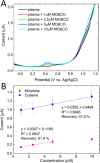Simultaneous Detection of Morphine and Codeine in the Presence of Ascorbic Acid and Uric Acid and in Human Plasma at Nafion Single-Walled Carbon Nanotube Thin-Film Electrode
- PMID: 31681878
- PMCID: PMC6822113
- DOI: 10.1021/acsomega.9b02147
Simultaneous Detection of Morphine and Codeine in the Presence of Ascorbic Acid and Uric Acid and in Human Plasma at Nafion Single-Walled Carbon Nanotube Thin-Film Electrode
Abstract
In clinical settings, the dosing and differential diagnosis of the poisoning of morphine (MO) and codeine (CO) is challenging due to interindividual variations in metabolism. However, direct electrochemical detection of these analytes from biological matrices is inherently challenging due to interference from large concentrations of anions, such as ascorbic acid (AA) and uric acid (UA), as well as fouling of the electrode by proteins. In this work, a disposable Nafion-coated single-walled carbon nanotube network (SWCNT) electrode was developed. We show facile electron transfer and efficient charge separation between the interfering anions and positively charged MO and CO, as well as significantly reduced matrix effect in human plasma. The Nafion coating alters the voltammetric response of MO and CO, enabling simultaneous detection. With this SWCNT/Nafion electrode, two linear ranges of 0.05-1 and 1-10 μM were found for MO and one linear range of 0.1-50 μM for CO. Moreover, the selective and simultaneous detection of MO and CO was achieved in large excess of AA and UA, as well as, for the first time, in unprocessed human plasma. The favorable properties of this electrode enabled measurements in plasma with only mild dilution and without the precipitation of proteins.
Copyright © 2019 American Chemical Society.
Conflict of interest statement
The authors declare no competing financial interest.
Figures





Similar articles
-
Electrochemical Detection of Oxycodone and Its Main Metabolites with Nafion-Coated Single-Walled Carbon Nanotube Electrodes.Anal Chem. 2020 Jun 16;92(12):8218-8227. doi: 10.1021/acs.analchem.0c00450. Epub 2020 May 28. Anal Chem. 2020. PMID: 32412733 Free PMC article.
-
Electrochemical detection of nanomolar dopamine in the presence of neurophysiological concentration of ascorbic acid and uric acid using charge-coated carbon nanotubes via facile and green preparation.Talanta. 2016 Jan 15;147:453-9. doi: 10.1016/j.talanta.2015.10.020. Epub 2015 Oct 8. Talanta. 2016. PMID: 26592632
-
Electrochemically selective determination of dopamine in the presence of ascorbic and uric acids on the surface of the modified Nafion/single wall carbon nanotube/poly(3-methylthiophene) glassy carbon electrodes.Colloids Surf B Biointerfaces. 2011 Dec 1;88(2):764-70. doi: 10.1016/j.colsurfb.2011.08.012. Epub 2011 Aug 22. Colloids Surf B Biointerfaces. 2011. PMID: 21907551
-
Multi-walled carbon nanotube modified carbon paste electrode as an electrochemical sensor for the determination of epinephrine in the presence of ascorbic acid and uric acid.Mater Sci Eng C Mater Biol Appl. 2013 Aug 1;33(6):3294-302. doi: 10.1016/j.msec.2013.04.010. Epub 2013 Apr 11. Mater Sci Eng C Mater Biol Appl. 2013. PMID: 23706213
-
Determination of Dopamine in the Presence of Ascorbic Acid by Nafion and Single-Walled Carbon Nanotube Film Modified on Carbon Fiber Microelectrode.Sensors (Basel). 2008 Nov 4;8(11):6924-6935. doi: 10.3390/s8116924. Sensors (Basel). 2008. PMID: 27873906 Free PMC article.
Cited by
-
Graphene quantum dots modified electrodes as electrochemical sensing tool towards the detection of codeine in biological fluids and soft drinks.Mikrochim Acta. 2024 Nov 4;191(12):722. doi: 10.1007/s00604-024-06787-2. Mikrochim Acta. 2024. PMID: 39489812
-
Electrochemical Determination of Morphine in Urine Samples by Tailoring FeWO4/CPE Sensor.Biosensors (Basel). 2022 Oct 27;12(11):932. doi: 10.3390/bios12110932. Biosensors (Basel). 2022. PMID: 36354441 Free PMC article.
-
Poly-taurine/poly-L-glutamic acid double-layer coating as potential candidates for surface modification of carbon felt electrode for discrimination and simultaneous detection of morphine and tramadol.Mikrochim Acta. 2025 Mar 24;192(4):249. doi: 10.1007/s00604-025-07034-y. Mikrochim Acta. 2025. PMID: 40126639
-
Prenatal alcohol exposure promotes NLRP3 inflammasome-dependent immune actions following morphine treatment and paradoxically prolongs nerve injury-induced pathological pain in female mice.Alcohol Clin Exp Res (Hoboken). 2023 Dec;47(12):2262-2277. doi: 10.1111/acer.15214. Epub 2023 Nov 5. Alcohol Clin Exp Res (Hoboken). 2023. PMID: 38151779 Free PMC article.
-
Electrochemical Detection of Oxycodone and Its Main Metabolites with Nafion-Coated Single-Walled Carbon Nanotube Electrodes.Anal Chem. 2020 Jun 16;92(12):8218-8227. doi: 10.1021/acs.analchem.0c00450. Epub 2020 May 28. Anal Chem. 2020. PMID: 32412733 Free PMC article.
References
LinkOut - more resources
Full Text Sources
Other Literature Sources
